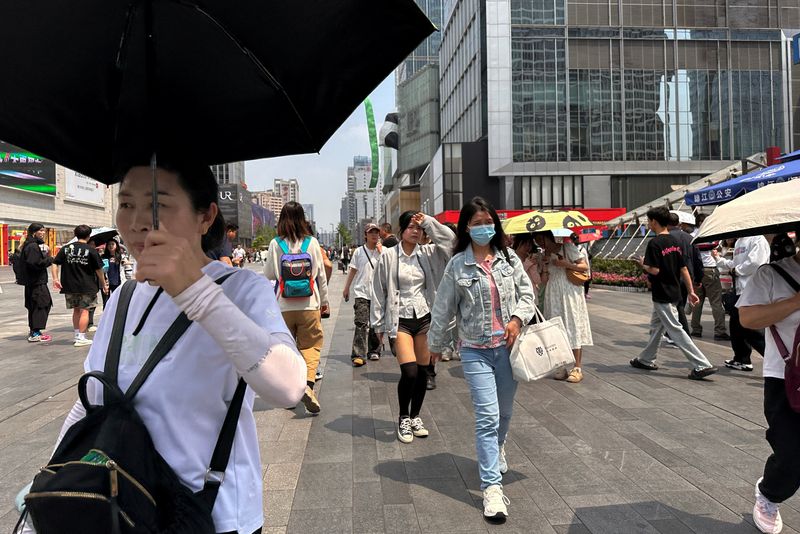By Kevin Yao and Ellen Zhang
BEIJING (Reuters) -China's bank lending tumbled more than expected in July, hitting the lowest in nearly 15 years, dragged down by tepid credit demand and seasonal factors and raising expectations that the central bank may dole out more easing steps.
Chinese banks extended 260 billion yuan ($36.28 billion) in new yuan loans in July, down nearly 88% from the previous month and also missing analysts' forecasts, according to data released by the People's Bank of China on Tuesday.
Analysts polled by Reuters had predicted new yuan loans would come in at 450 billion yuan last month, noting that July is traditionally a weak period for credit expansion.
After the data, some analysts said they expected the PBOC to cut interest rates further, but it may have to tread cautiously for fear of fuelling capital flight and hurting the yuan currency.
"July's credit data is indeed very weak," said Zhou Shilei, director of the global financial market department at UOB (China). "The effect of previous interest rate cuts is not significant, and there are expectations for further rate cuts."
Last month's new yuan loans dipped from June's 2.13 trillion yuan and compared with 345.9 billion yuan a year earlier.
Banks extended 13.53 trillion yuan in new yuan loans in the first seven months of this year, the PBOC said.
The central bank did not provide a single month breakdown for July but Reuters calculated the figure based on the bank's January-July data, compared with January-June.
Household loans, mostly mortgages, contracted 210 billion yuan in July, compared with a rise of 570.9 billion yuan in June, according to Reuters calculations based on the PBOC data. Corporate loans dropped to 130 billion yuan from 1.63 trillion yuan in June.
The PBOC's survey of bankers published last week suggested loan demand weakened significantly in the second quarter, with the overall loan demand index falling to 55.1% from 71.5% in the previous quarter.
Central bank chief Pan Gongsheng has said a slowdown in China's credit expansion is natural due to factors such as economic shifts and less lending to the property sector and local government financing vehicles.
China's economic growth missed forecasts in the second quarter, while July economic indicators also offered little cheer as export growth slowed and consumer inflation got a boost only due to weather disruptions to food supplies.
MORE RATE CUTS EXCEPTED
The PBOC pledged to guide credit to grow reasonably and steadily lower companies' financing and household credit costs, the bank said in its second-quarter monetary policy implementation report published last week.
At a meeting earlier this month to discuss policies for the second half of 2024, the PBOC said it would step up financial support to the broader economy and efforts would be directed more at consumers to spur consumption.
To bolster growth, the PBOC unexpectedly conducted a medium-term lending facility operation on July 25 and cut the interest rate, while five of China's major state-owned banks on the same day cut deposit rates to cushion a hit to their already record low margins.
"With private credit demand still lacklustre, the PBOC’s recent rate cuts aren’t significant enough to drive much of a recovery," Capital Economics said in a note.
"We’re only expecting a further 20bps of cuts to the loan prime rate this year, which won’t be sufficient to drive a sustained resurgence in credit demand."
Outstanding yuan loan growth slowed to 8.7% from a year earlier, compared with 8.8% in June. Analysts had expected an 8.8% gain.
There were signs of steadying in some key money gauges.
Last month, broad M2 money supply rose 6.3% versus a year earlier, beating the 6.1% forecast in a Reuters poll and a record low of 6.2% in June.
Annual growth of outstanding total social financing, a broad measure of credit and liquidity in the economy, sped up to 8.2% from 8.1% in June.

In July, total social financing fell to 770 billion yuan, compared with forecasts of 1.1 trillion yuan, and 3.3 trillion yuan in June.
($1 = 7.1656 Chinese yuan renminbi)